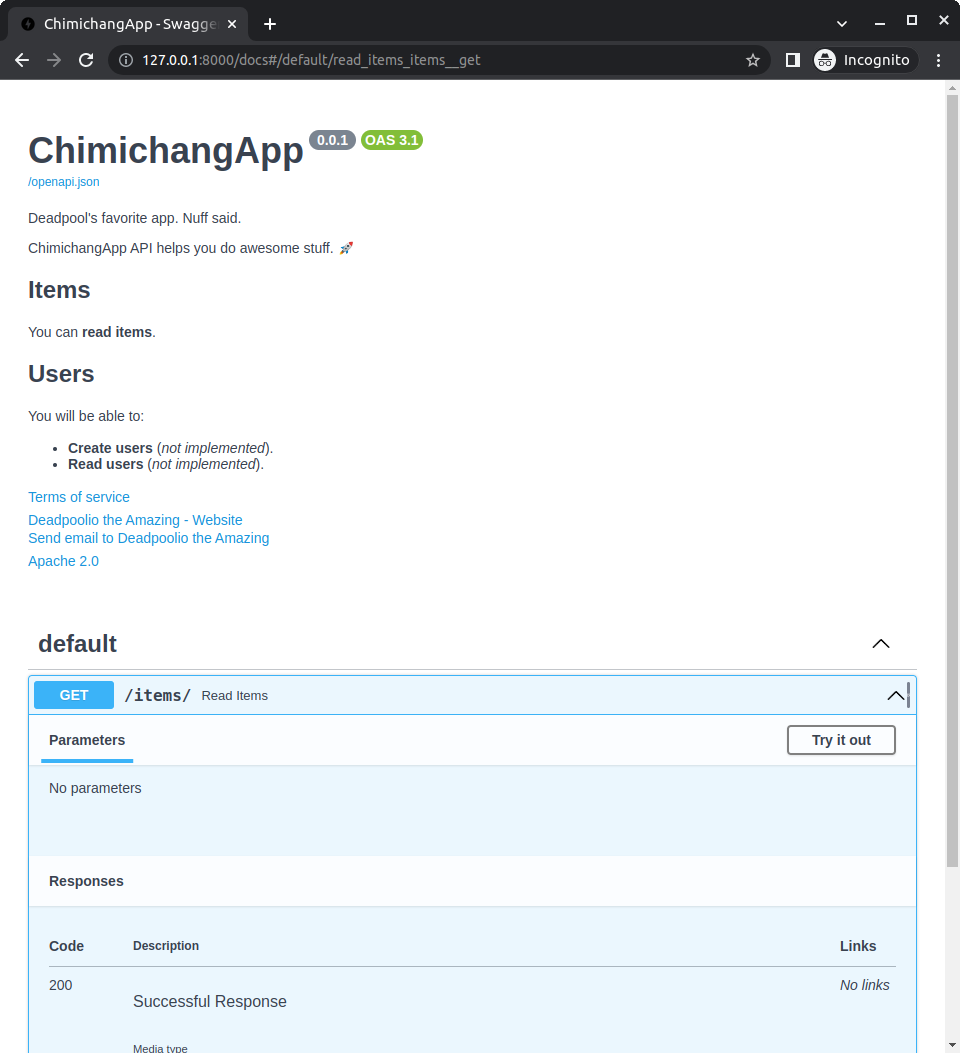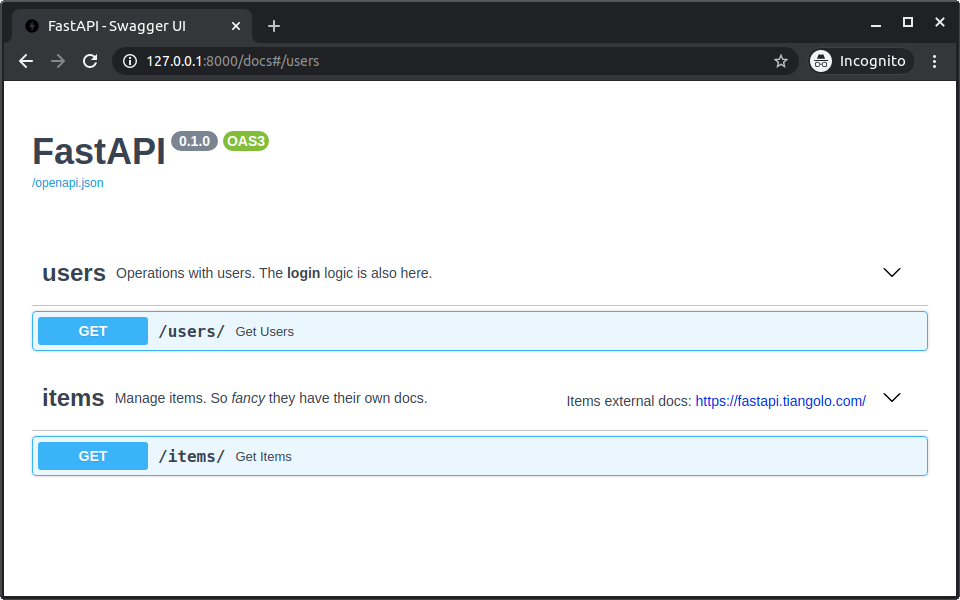元数据和文档 URL¶
你可以在你的 FastAPI 应用中自定义多个元数据配置。
API 元数据¶
你可以设置以下字段,它们将被用于 OpenAPI 规范和自动生成的 API 文档 UI 中
| 参数 | 类型 | 描述 | ||||||||||||
|---|---|---|---|---|---|---|---|---|---|---|---|---|---|---|
title |
str |
API 的标题。 | ||||||||||||
summary |
str |
API 的简短摘要。 自 OpenAPI 3.1.0,FastAPI 0.99.0 起可用。 | ||||||||||||
description |
str |
API 的简短描述。可以使用 Markdown。 | ||||||||||||
version |
string |
API 的版本。这是你自己的应用程序版本,而非 OpenAPI 版本。例如 2.5.0。 |
||||||||||||
terms_of_service |
str |
API 服务条款的 URL。如果提供,必须是一个 URL。 | ||||||||||||
contact |
dict |
对外暴露 API 的联系信息。可以包含多个字段。
|
| 参数 | 类型 | 描述 |
|---|---|---|
name | str | 联系人/组织的标识名称。 |
url | str | 指向联系信息的 URL。必须是 URL 格式。 |
email | str | 联系人/组织的电子邮件地址。必须是电子邮件地址格式。 |
license_infodictlicense_info 字段
| 参数 | 类型 | 描述 |
|---|---|---|
name | str | 必需 (如果设置了 license_info)。用于 API 的许可证名称。 |
identifier | str | 一个 SPDX API 许可证表达式。该 identifier 字段与 url 字段互斥。 自 OpenAPI 3.1.0,FastAPI 0.99.0 起可用。 |
url | str | 指向用于 API 许可证的 URL。必须是 URL 格式。 |
你可以按如下方式设置它们
from fastapi import FastAPI
description = """
ChimichangApp API helps you do awesome stuff. 🚀
## Items
You can **read items**.
## Users
You will be able to:
* **Create users** (_not implemented_).
* **Read users** (_not implemented_).
"""
app = FastAPI(
title="ChimichangApp",
description=description,
summary="Deadpool's favorite app. Nuff said.",
version="0.0.1",
terms_of_service="http://example.com/terms/",
contact={
"name": "Deadpoolio the Amazing",
"url": "http://x-force.example.com/contact/",
"email": "dp@x-force.example.com",
},
license_info={
"name": "Apache 2.0",
"url": "https://apache.ac.cn/licenses/LICENSE-2.0.html",
},
)
@app.get("/items/")
async def read_items():
return [{"name": "Katana"}]
提示
你可以在 description 字段中编写 Markdown,它将在输出中渲染。
通过此配置,自动生成的 API 文档将如下所示

许可证标识符¶
自 OpenAPI 3.1.0 和 FastAPI 0.99.0 起,你还可以使用 identifier 设置 license_info,而不是 url。
例如:
from fastapi import FastAPI
description = """
ChimichangApp API helps you do awesome stuff. 🚀
## Items
You can **read items**.
## Users
You will be able to:
* **Create users** (_not implemented_).
* **Read users** (_not implemented_).
"""
app = FastAPI(
title="ChimichangApp",
description=description,
summary="Deadpool's favorite app. Nuff said.",
version="0.0.1",
terms_of_service="http://example.com/terms/",
contact={
"name": "Deadpoolio the Amazing",
"url": "http://x-force.example.com/contact/",
"email": "dp@x-force.example.com",
},
license_info={
"name": "Apache 2.0",
"identifier": "MIT",
},
)
@app.get("/items/")
async def read_items():
return [{"name": "Katana"}]
标签元数据¶
你还可以通过参数 openapi_tags 为用于分组路径操作的不同标签添加额外元数据。
它接受一个列表,其中包含每个标签的一个字典。
每个字典可以包含
name(必需):一个str字符串,其值与你在tags参数中使用的标签名称相同,用于你的 路径操作 和APIRouter。description:一个str字符串,用于标签的简短描述。它可以使用 Markdown,并将在文档 UI 中显示。externalDocs:一个dict字典,描述外部文档,包含description:一个str字符串,用于外部文档的简短描述。url(必需):一个str字符串,包含外部文档的 URL。
创建标签元数据¶
让我们以包含 users 和 items 标签的示例来尝试。
创建标签的元数据并将其传递给 openapi_tags 参数
from fastapi import FastAPI
tags_metadata = [
{
"name": "users",
"description": "Operations with users. The **login** logic is also here.",
},
{
"name": "items",
"description": "Manage items. So _fancy_ they have their own docs.",
"externalDocs": {
"description": "Items external docs",
"url": "https://fastapi.org.cn/",
},
},
]
app = FastAPI(openapi_tags=tags_metadata)
@app.get("/users/", tags=["users"])
async def get_users():
return [{"name": "Harry"}, {"name": "Ron"}]
@app.get("/items/", tags=["items"])
async def get_items():
return [{"name": "wand"}, {"name": "flying broom"}]
请注意,你可以在描述中使用 Markdown,例如 "login" 将以粗体显示 (login),"fancy" 将以斜体显示 (fancy)。
提示
你不必为你使用的所有标签都添加元数据。
使用你的标签¶
使用 tags 参数,将你的 路径操作 (和 APIRouter) 分配到不同的标签
from fastapi import FastAPI
tags_metadata = [
{
"name": "users",
"description": "Operations with users. The **login** logic is also here.",
},
{
"name": "items",
"description": "Manage items. So _fancy_ they have their own docs.",
"externalDocs": {
"description": "Items external docs",
"url": "https://fastapi.org.cn/",
},
},
]
app = FastAPI(openapi_tags=tags_metadata)
@app.get("/users/", tags=["users"])
async def get_users():
return [{"name": "Harry"}, {"name": "Ron"}]
@app.get("/items/", tags=["items"])
async def get_items():
return [{"name": "wand"}, {"name": "flying broom"}]
信息
在 路径操作配置 中阅读更多关于标签的信息。
检查文档¶
现在,如果你查看文档,它们将显示所有附加元数据

标签顺序¶
每个标签元数据字典的顺序也定义了在文档 UI 中显示的顺序。
例如,尽管 users 在字母顺序上会排在 items 之后,但它会显示在它们之前,因为我们将其元数据作为列表中的第一个字典添加。
OpenAPI URL¶
默认情况下,OpenAPI 模式在 /openapi.json 提供服务。
但你可以使用参数 openapi_url 配置它。
例如,要将其设置为在 /api/v1/openapi.json 提供服务
from fastapi import FastAPI
app = FastAPI(openapi_url="/api/v1/openapi.json")
@app.get("/items/")
async def read_items():
return [{"name": "Foo"}]
如果你想完全禁用 OpenAPI 模式,可以设置 openapi_url=None,这也会禁用使用它的文档用户界面。
文档 URL¶
你可以配置包含的两个文档用户界面
- Swagger UI: 在
/docs提供服务。- 你可以使用参数
docs_url设置其 URL。 - 你可以通过设置
docs_url=None来禁用它。
- 你可以使用参数
- ReDoc: 在
/redoc提供服务。- 你可以使用参数
redoc_url设置其 URL。 - 你可以通过设置
redoc_url=None来禁用它。
- 你可以使用参数
例如,将 Swagger UI 设置为在 /documentation 提供服务并禁用 ReDoc
from fastapi import FastAPI
app = FastAPI(docs_url="/documentation", redoc_url=None)
@app.get("/items/")
async def read_items():
return [{"name": "Foo"}]